FINAL: Endocrine system (15,16,17)
1/113
There's no tags or description
Looks like no tags are added yet.
Name | Mastery | Learn | Test | Matching | Spaced | Call with Kai |
|---|
No study sessions yet.
114 Terms
Hormones
are chemical messengers that enter the blood which carries them from their site of secretion to the cells upon which they act
The endocrine system is made up of
cells , tissues, and organs that secrete hromone’s into body fluids
What are the master regulators of homeostasis
nervous system and endocrine system
Name the two types of glands in the body
exocrine and endocrine
Exocrine
secrete their products into a duct from where the secretion either exits the body (like sweat) or enters the lumen of another organ such as the intestines
(SECRETE PRODUCTS INTO DUCTS FOR EXCRETION)
Endocrine
are ductless and release hormones into the blood
hormones are first released into the interstitial fluid , from where thye diffuse into the blood to reach a distant target cell
(SECRETE PRODUCTS INTO BODY FLUIDS TO AFFECT TARGET CELLS/ORGANS)
A type of endocrine gland is the hypothalamus explain what it does
hypothalamus secretes several neurohormones that stimulate or inhibit anterior pituitary gland function. Synthesizes two neurohormones that are stored in and released from the posterior pituitary.
A type of endocrine gland is the adrenal glands (cortex and medulla) explain what id does
Makes epinephrine and norepinephrine, which mediate the fight-or-fight response.
A type of endocrine gland is the cortex explain what it does
Makes aldosterone, which regulates Na+ and K+ balance; makes cortisol, which regulates growth, metabolism, development, immune function,and the response to stress;makes some androgens,which play a role in reproduction.
A type of endocrine gland is the liver explain what it does
Produces insulin-like growth factor-1, which controls growth
of bones; secretes angiotensinogen, a precursor required for production of angiotensin Il.
A type of endocrine gland is kidneys explain what it does
Secrete erythropoietin, which regulates maturation of red
blood cells; produce the active hormone 1,25-dihydroxyvitamin D; secrete the enzyme renin, which begins the synthesis of the hormone angiotensin II (see blood vessels).
A type of endocrine gland is pancreas explain what it does
Makes insulin, which decreases blood glucose, and releasing glucagon, which increases blood glucose.
A type of endocrine gland is blood vessels explain what it does
Cells of many blood vessel walls express enzymes that are required to complete the synthesis of angiotensin Il, which helps maintain normal blood pressure.
A type of endocrine gland is adipose tissue explain what it does
Produces hormones (for example, leptin), which regulate appetite and metabolic rate
A type of endocrine gland is parathyroids (behind the thyroid) explain what it does
Make parathyroid hormone, which increases blood Ca?*, and stimulates the production in the kidneys of the active form of
vitamin D
A type of endocrine gland is ovaries explain what it does
Ovaries (in females):
Produce estrogens—such as estradiol—and progesterone, which control female reproduction
A type of endocrine gland is testes (in males) explain what it does
Produce androgens, such as testosterone, which control male reproduction
What are the three main classes of hormones
Amines
Peptides and proteins
Steroids
Amine hormones
The amine hormones are iodine-containing thyroid hormones and the catecholamines (Epinephrine, norepinephrine, and dopamine) secreted by the adrenal medulla and hypothalamus
are derived from amino acids and include hormones such as epinephrine and thyroid hormones, playing crucial roles in various physiological processes.
Adrenal medulla secretes two catecholamines (NE,E)
-Dopamine is synthesized by neurons in the hypothalamus
why do you think insulin can be administered so quickly to regulate glucose levels, if insulin were a steroid hormone would you expect it ot have such rapid effects
Insulin is able to be administered quickly and act rapidly to regulate glucose levels because it is a peptide hormone, which is water-soluble and acts through cell surface receptors. This allows insulin to trigger fast signaling pathways within the target cells, especially in tissues like muscle and fat, to facilitate the uptake of glucose, increase glycogen storage in the liver, and lower blood sugar levels quickly. The effects are often observed within minutes to hours, which is why insulin is used as an immediate treatment for regulating blood glucose.
If insulin were a steroid hormone, it would likely not have such rapid effects. Steroid hormones are lipid-soluble and act by passing through the cell membrane to bind with intracellular receptors, usually affecting gene expression and protein synthesis. This process takes longer because it involves transcription and translation of new proteins, and these cellular changes take time to produce noticeable effects, often taking hours to days.
In summary, the rapid action of insulin is due to its peptide structure, which allows for quick signaling at the cell surface, while a steroid-based insulin would require a much slower mechanism involving changes in gene expression, leading to slower metabolic effects
Steroid hormones
are produced by cholesterol by the adrenal cortex and the gonads, and by the placenta during pregancy
-predominant steroid hormones are produced by the adrenal cortex are aldosterone, cortisol, DHEA, and androstenedione
ovaries mainly produce
estradiol and progesterone
Testes mainly produce
testosterone
Adrenal gland hormone synthesis
in the cortex it is organized into distinct structural and functional layers
Adrenal cortex secretes aldosterone, cortisol, and androgens
Adrenal medulla secretes epinephrine and norepinephrine
Explain peptide and catecholamine hormones transport
-Form: free (unbound to protein)
Peptide(i.e insulin) and catecholamines (E,NE, Dopamine), are water soluble so they are transported in dissolved plasma
-there receptors are located on the plasma membranes in which they directly bind to on the surface of the target cells
They signal a cascade of intracellular events through secondary messengers.
1. Hormone binds receptor on surface on plasma membrane
2. activating a G protein
3. Producing adenylate cyclase
4. producing cAMP
5. cAMP activates PKA allowing for phosphorylation and activates cascade leading to intracellular changes
.Explain steroid and thyroid hormone transport in the blood
-they are not water soluble, instead they are lipid soluble and pass through the cell membranes to bind intracellular receptors
-they are protein bound
-intracellular receptors directly alter gene expression which takes longer, so this process is slow
What are the major organs that remove hormones by metabolizing and/or excreting them
liver and kidneys are the major organs
Explain which hormones are rapidly removed from blood and which are not?
peptide and catecholamine hormones are rapidly removed from blood whereas steroid and thyroid hormones are removed more slowly in part because they are circulating bound to plasma protein
-so peptide and catecholamine hormones can enter the filtrate → since they are protein free allowing them to be excreted as urine
Where are the receptors for steroid and thyroid hormones?
they are located inside their target cells
-they are lipid soluble steroid hormones diffuses through the cell membrane, binding intracellular receptors inside the cell/nucleus and the resulting hormone-receptor complex binds regions of the target cells DNA altering transcription of specific genes involved to the hormones signal
Where are receptors for peptide and catecholamine hormones
on the plasma membrane of their target cells
What are the factors that alter rate of hormone secretion in a endocrine cell?
(Ions/nutrients, neurotransmitter, hormones (tropic)
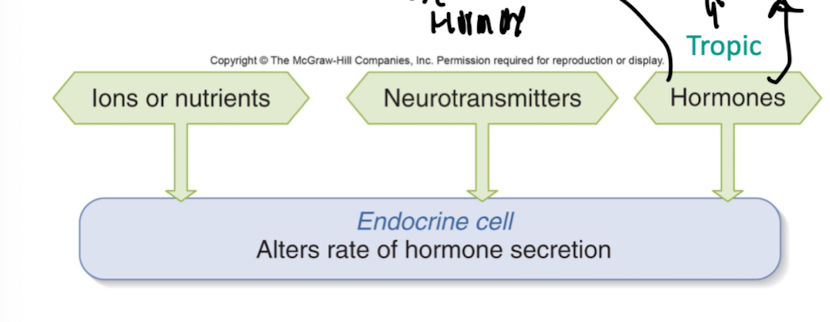
Explain the flowchart when plasma glucose concentration increases
increase in plasma glucose concentration
increase in insulin secretion from insulin secreting cells
increase in plasma insulin concentration
increase in action insulin (which transports glucose from extracellular to intracellular fluid) from insulin targets cells
remember insulin is a peptide hormone
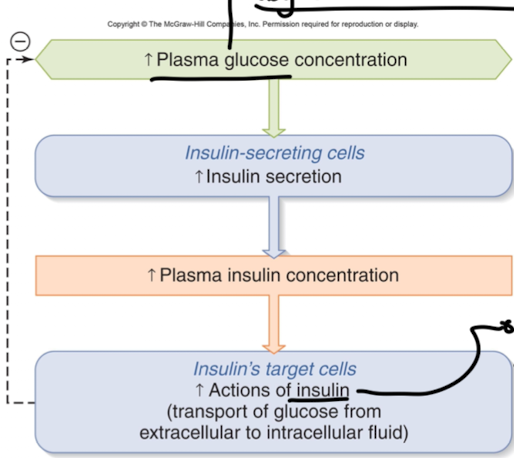
Explain what the outcome of the hormone can be once the endocrine cell secretes the hormone? flowchart
Endocrine cell: secretes hormone
Hormone is now circulating in blood
It can either be excreted in urine/feces, OR be inactivated by metabolism,
OR, be activated by metabolism
if activated by metabolism it can go to target cells and bind to receptor and produce a cellular reponse, (it can also just directly bind to the receptor)
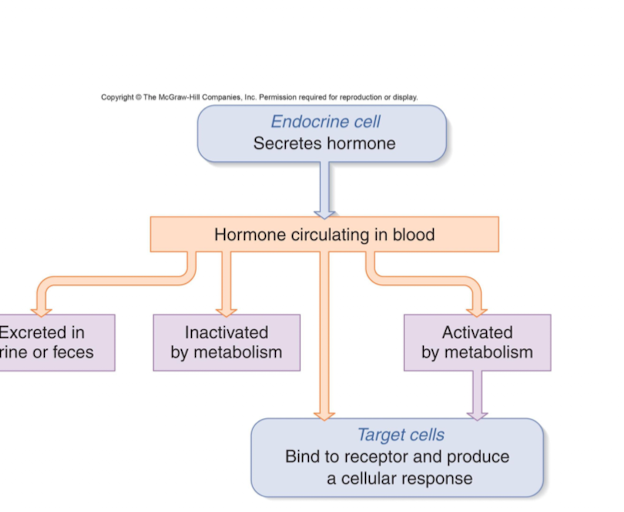
How does the autonomic nervous system control hormone secretion?
by the adrenal medulla and endocrine gland cell
In the autonomic nervous system, the adrenal medulla is modified by what?
sympathetic ganglion cells , and is stimulated by sympathetic pre-ganglionic fibers releasing epinephrine
what are the four types of endocrine disorders
hypo-secretion, hyper-secretion, hypo-responsiveness, and hyper-responsiveness
Hyposecretion is a type of endocrine disorders that
has too little hormone secretion
hypersecretion is a type of endocrine disorder that
has too much hormone secretion
Hyporesponsiveness
is when there is decreased responsiveness of the target cell to the hormone (deficiency/loss of function of target cell receptors or downstream intracellular signaling )
Hyperresponsiveness
is when there is increased responsiveness of the target cell to the hormone (synergistic effects of hormones-permissiveness)
Primary disorder
defect occurs inn the cells/tissue that secretes the hormone
secondary disorders
defect occurs as a result of hypo/hyper secretion of a tropic hormone
where are the hypothalamus and pituitary gland located?
In the brain
The pituitary is dividied into
into an anterior and posterior portions
The anterior pituitary does what?
secretes hormones is response to hypo-physiotropic hormones(which are hormones that are produced by the hypothalamus and regulate release from the pituitary gland )
The posterior pituitary gland is
just an extension of axons from the hypothalamus that terminate there, releasing posterior pituitary hormones
Often hormone secretion sequences/pathways initiate with
initiate with tropic hormones from the hypothalamus and pituitary gland
Explain the general pathway of the 3 pathway sequence flow chart, no need to say a specific hormone
stimulis
hypothalamus increases hormone 1 secretion
increase in plasma 1 secretion in the hypothalamo-hypophyseal portal vessels
increase hormone 2 secretion in anterior pituitary
increase in plasma hormone 2
third endocrine gland: increase in hormone 3 secretion
increase in plasma hormone 3
target cells of hormone 3 respond to hormone 3
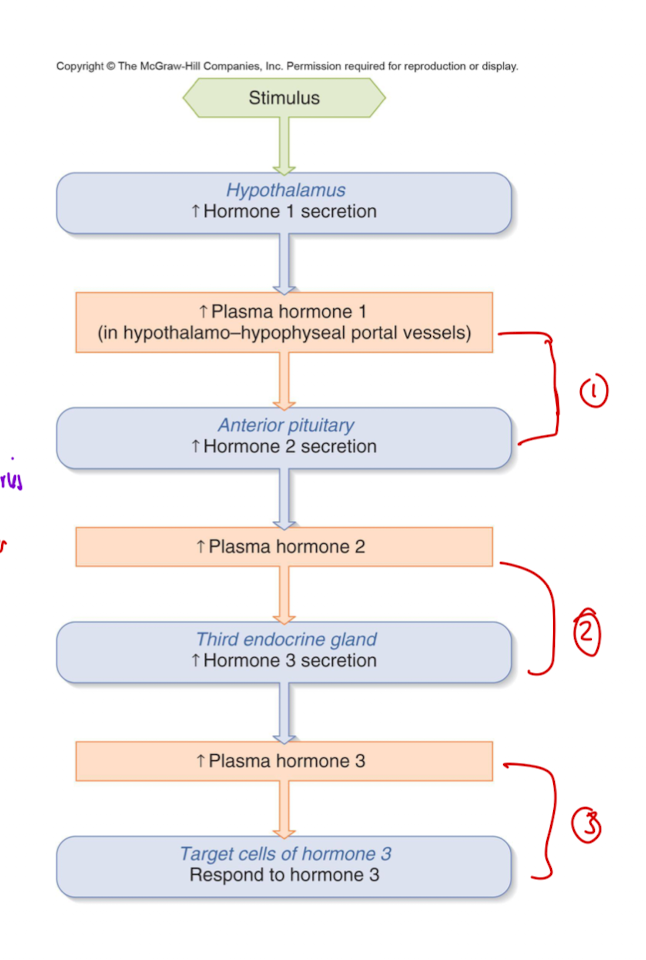
Secretion of anterior pituitary gland is controlled by
the hypo-physiotropic hormones which are secreted into the portal vessels connecting the hypothalamus and pituitary
The hypothalamo-hypophyseal portal vessels connect
the capillary bed of the hypothalamus to the second capillary bed of the anterior pituitary gland and facilitate the transport of hormones.
Why is anterior pituitary hormone secretion more efficient ?
the local route for the hypophysiotropic hormones to travel directly from the hypothalamus to act on the anterior pituitary (bypassing general circulation) which allows for more efficient regulation of anterior pituitary hormone secretion
Why does it take only very small quatities of hypophysiotropic hormones to achieve concentrations that are effective in regulating anterior pituitary gland hormone secretion
this is due to the hypothalamo-hypophyseal portal vessels
-the volume of blood is low
What hormones are secreted by posterior pituitary gland
vasopressin : involved in regulation of water balance
and oxytocin: involved in milk ejection reflex of nursing mothers and emotional bonding
Gonadotropin releasing hormone (GNRH) secretes what from the hypothalamus
stimulates secretion of LH and FSH from the anterior pituitary gland.
Name the major hypophysiotropic hormones
Gonadotropic releasing hormone (GnRH), Growth hormone releasing hormone (GHRH), somatostatin (SST), Thyroid releasing hormone (TRH), Dopamine (DA) , and Corticotropin releasing hormone (CRH)
Growth Hormone releasing hormone is secreted from hypothalamus which stimulates secretion of
growth hormone from the anterior pituitary gland
Somatostatin (SST) is secreted from the hypothalamus which
inhibits secretion of growth hormone
Thyroid releasing hormone is released from the hypothalamus which stimulate secretion of
thyroid-stimulating hormone (TSH) from the anterior pituitary gland.
Dopamine is released from the hypothalamus and does what
it inhibits secretion of prolactin
Corticotropin-releasing hormone (CRH) is released from the hypothalamus and does what
it stimulates secretion of adrenocorticotropic hormone (ACTH) from the anterior pituitary gland.
FSH and LH stimulate the gonads which
which is important for germ cell development and secrete hormones
Growth hormone stimulates livers and other cells to
Livers and other cells :secrete insulin-like growth factors-1 (IGF-1)
Many organs and tissues:protein synthesis, metabolism
thyroid stimulating hormone (TSH) stimulates
stimulates the thyroid to secrete thyroxine (T4) and triiodothyronine (T3)
Prolactin stimulates
the breasts for breast development and milk production
adrenocorticotropic hormone (ACTH) stimulates
adrenal cortex to secrete cortisol
If all the neural connections between the hypothalamus and the pituitary gland were severed , the secretion of which pituitary gland hormones would be affected?
The posterior pituitary hormones would be affected since they are just an extension of axons from the hypothalamus while the anterior is released into the blood (hormonal blood based)
The thyroid gland sits within
the neck straddling the trachea
What produce and secretes thyroid hormones?
follicular epithelial cells of the thyroid gland.
What are the two iodine containing thyroid hormones ?
T3: triiodothyronine
T4: thyroxine
Explain T3 and T4
T4 is the main secretory product of the thyroid gland, but T3 is the active hormone (produced from T4 in target tissues)
What stimulates T3(triiodothyronine) and T4(thyroxine)
thyroid stimulating hormone (TSH)
Aside from TSH stimulating T3/T4 what else does it stimulate?
it stimulates growth (cell division/hypertrophy) of thyroid tissue- where excessive TSH can lead to the formation of a goiter
What feeds back on the anterior pituitary gland? in regards to thyroid gland
T3 and T4
Explain what T3 does
it increases metabolic rate and promotes the consumption of calories→ resulting in increased heat production. It stimulates carbohydrate abosrption and fatty acid release providing energy to maintain high metabolsim
it has permissive effects on catecholamines (permissive actions). It up regulates beta adrenergic receptors in many tissues (heart and nervous system) , potentiating sympathetic nervous system activity
it is required for the normal production of growth hormone by the anterior pituitary gland (important for normal growth and development, and nervous system function)
Clinical Issues:Hypothyroidism AKA HASIMOTO’s Disease (explain what is is and effects, and how it is treated)
most commonly results from autoimmune destruction of all or part of the thyroid gland (HASHIMOTOS disease)
characterized by weight gain, fatigue, cold intolerance, and changes in skin tone and cognition, may result in goiter
it can result from iodine efficiency
can be treated with the administration of thyroxine (T4)
Clinal issues: hyperthyroidiism (GRAVES disease) explain what it is, what it causes, how its treated
is typically the result of an autoimmune disorder where antibiodies agonize TSH receptors
characterized by weight loss, heat intolerance, irritabillity and anxiety, and can lead to a goiter
can have dangerous affects on the cardiovascular system
treated with drugs that inhibit T3 synthesis/ and or removal of thyroid tissue or even radioactive iodine
How does hashimotos disease lead to a goiter
In Hashimoto's disease, the autoimmune destruction of thyroid tissue leads to an inadequate production of thyroid hormones, stimulating the pituitary gland to produce more TSH. This excess TSH can cause the thyroid gland to enlarge, resulting in a goiter.
How can graves disease lead to production of goiter
T3 and T4 Increase: Since the thyroid is being overstimulated, it produces excessive amounts of T3 (triiodothyronine) and T4 (thyroxine).
TRH and TSH Decrease: The hypothalamus and pituitary gland normally regulate thyroid hormone levels through a feedback loop:
The hypothalamus produces TRH (thyrotropin-releasing hormone), which stimulates the pituitary to release TSH (thyroid-stimulating hormone).
TSH stimulates the thyroid to produce T3 and T4.
However, when the levels of T3 and T4 rise too high (as in Graves' disease), the negative feedback mechanism kicks in:
High levels of T3 and T4 signal the hypothalamus and pituitary to reduce TRH and TSH production.
As a result, TSH levels drop significantly, often to very low or undetectable levels, because the thyroid is already being overstimulated by the autoantibodies.
Growth (lengthening of the shaft) stops when
the epiphyseal plates close after puberty. / when the growth plates are completely converted to bone
Osteoblasts
secrete collagen to form a matrix to which calcium is deposited -mineralization of bone
osteoclasts
break down bone to release ca+ stored into the blood (resporption)
epiphyseal growth plates
convert cartilage to bone
chondrocytes
cells that produce cartilage and are involved in the growth and maintenance of cartilage tissue.
What are the major hormones influencing growth
GH, insulin, TH, testosterone, estrogen, cortisol
growth hormone (GH)
major stimulus of postnatal growth: it induces precursor cells to differentiate and secrete IGF-1 which stimulates cell division
-stimultes liver to secrete IGF-1
stimulates protein synthesis
Insulin influences growth
stimulates fetal growth, stimulates postnatal growth by stimulating secretion of IGF1
stimulates protein synthesis
thyroid hormone
permissive for growth hormones secretion and actions
permissive for development of the cenrral nervous system
testosterone
stimulates growth at puberty, stimulating secretion of growth hormone, causes epiphyseal closure , stimulates protein synthesis in male
estrogen
stimulates secretion of growth hormone at puberty
causes epiphyseal closure
cortisol
inhibits growth
stimulates protein catabolism
What is a major stimulus for postnatal growth? explain what it does
Growth hormone, it can directly promote growth in target tissues by stimulating protein synthesis, most of its effects are exerted by stimulating the secretion of insulin like growth factor 1 (IGF1) in the liver
GH STIMULATES:
bone and other tissues to differentiate and secrete IGF1
liver to secrete IGF1
-protein synthesis in muscle
IGF-1 acts locally and systemically to promote cell division
Explain how growth hormone can also promote energy availabillity via its anti-insulin effects
release and breakdown of fat stores
stimulates gluconeogenesis
decreases effectiveness of insulin
Explain the pathway controlling the release of growth hormone
Stimulus: excercise, stress, low plasma glucose, sleep
hypothalamus: increases secretion of GHRH and decreases secretion of SST (somatostatin inhibits secretion of GH)
Increase plasma GHRH and decrease plasma SST in the hypothalamo-hypophyseal portal vessels
anterior pituitary gland: increases secretion of GH
increases plasma GH
Liver and other cells: secrete insulin growth factor 1 (IGF1)
increasing plasma IGF1
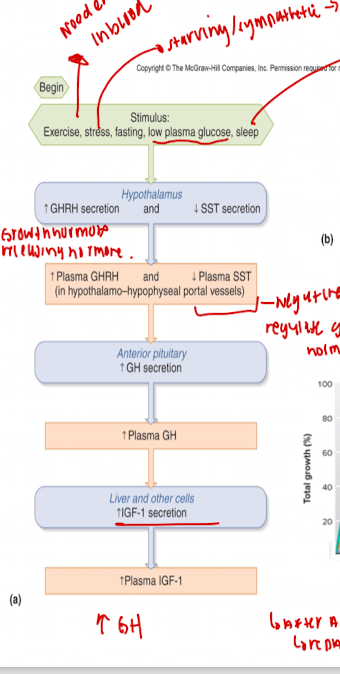
Clinical issues: Short stature
can be caused by hyposecretion of GH and or/ IGF-1 during childhood development
-there is too little Gh → leading to decrease IGF-1
Clinical issue: Gigantism
can be caused by hypersecretion of GH before puberty. (very tall)
Clinical issue:Acromegaly
can be caused by hypersecretion of GH after puberty. Charcaterized by enlarged organs . Growth plates are closed so long bones cant respond instead there is growth of other tissue
Insulin promotes
the uptake of glucose into adipose and skeletal muscle tissue for consumption (growth) and inhibits protein degradation. Very important during fetal growth/development
Cortisol (stress hormone) has what effects on growth
inhibitory effects on growth
-stimulting protein and bone breakdown, inhibiting bone growth and IGF1 secretion
What are three effector sites for regulation of body calcium
Bone: 99% of calcium stored in bone as minerals on collagen matrix, and calcium storage/release is regulated
Gastrointestinal tract: absoprtion of calcium from the diet is regulated
Kidneys: excretion of calcium in the urine is regulated
Resoprtion:
osteoclasts break down bone to release Ca+ stores into the blood